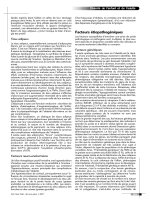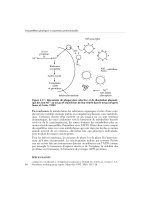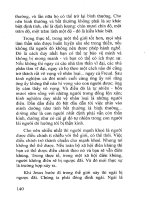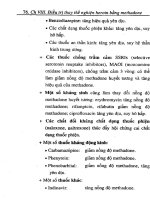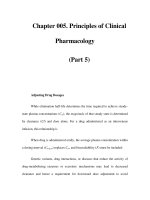Chapter 056. Cutaneous Drug Reactions (Part 5) doc
Bạn đang xem bản rút gọn của tài liệu. Xem và tải ngay bản đầy đủ của tài liệu tại đây (14.66 KB, 5 trang )
Chapter 056. Cutaneous
Drug Reactions
(Part 5)
Onychomadesis
Onychomadesis is caused by temporary arrest of nail matrix mitotic
activity. Common drugs reported to induce onychomadesis include
carbamazepine, lithium, retinoids, and chemotherapeutic agents such as
cyclophosphamide and vincristine.
Paronychia
Paronychia and multiple pyogenic granuloma with progressive and painful
periungual abscess of fingers and toes are a side effect of systemic retinoids,
lamivudine, indinavir, and anti-EGFR monoclonal antibodies (cetuximab,
gefitinib).
Nail Discoloration
Some drugs, including anthracyclines, taxanes, fluorouracil, and
zidovudine, may induce nail bed hyperpigmentation through melanocyte
stimulation. It appears to be reversible and dose-dependent.
PRURITUS
Pruritus is a common symptom of most drug eruptions, but it may also
occur without skin lesions as the only manifestation of drug intolerance. Severe
pruritus may occur in up to 50% of African patients treated with antimalarials and
lead to poor compliance. It is much rarer in Caucasians.
Immune Cutaneous Reactions: Benign
MACULOPAPULAR ERUPTIONS
Morbilliform or maculopapular eruptions are the most common of all drug-
induced reactions, often start on the trunk or areas of pressure or trauma, and
consist of erythematous macules and papules that are frequently symmetric and
may become confluent. Involvement of mucous membranes is unusual, with the
exception of scaly lips; the eruption may be associated with moderate to severe
pruritus and fever. Diagnosis is rarely assisted by laboratory testing. Skin biopsy is
useless because it shows normal skin or very mild and nonspecific changes. A
viral exanthem is the principal differential diagnostic consideration, especially in
children. Absence of enanthems, absence of symptoms in ears, nose, and throat
and upper respiratory tract, and polymorphism of the skin lesions support a drug
rather than a viral eruption.
Maculopapular reactions usually develop within 1 week of initiation of
therapy and last less than 2 weeks. Occasionally these eruptions may decrease or
fade with continued use of the responsible drug. Since the eruption may also
worsen, the suspect drug should be discontinued unless it is essential. Oral
antihistamines, emollients, and soothing baths may help relieve pruritus. Short
courses of potent topical glucocorticoids can reduce inflammation and symptoms.
Systemic glucocorticoid treatment is rarely indicated.
URTICARIA/ANGIOEDEMA
Urticaria is the second most frequent type of cutaneous reaction to drugs.
However, "drug allergy" explains no more than 10–20% of acute urticaria cases. It
is a skin reaction characterized by pruritic, red wheals of varying size. Individual
lesions rarely last more than 24 h. Deep edematous dermal and subcutaneous
tissues are known as angioedema. Angioedema may involve mucous membranes.
Urticaria and angioedema may be part of a life-threatening anaphylactic reaction.
Drug-induced urticaria may be caused by three mechanisms: an IgE-
dependent mechanism, circulating immune complexes (serum sickness), and
nonimmunologic activation of effector pathways. IgE-dependent urticarial
reactions usually occur within 36 h of drug exposure but can occur within minutes.
Immune complex–induced urticaria associated with serum sickness usually occurs
6–12 days after first exposure. In this syndrome, the urticarial eruption may be
accompanied by fever, hematuria, arthralgias, hepatic dysfunction, and neurologic
symptoms.
Certain drugs, such as NSAIDs, ACE inhibitors, angiotensin II antagonists,
and radiographic dyes, may induce urticarial reactions, angioedema, and
anaphylaxis in the absence of drug-specific antibody. Although ACE inhibitors,
aspirin, penicillin, and blood products are the most frequent causes of urticarial
eruptions, urticaria has been observed in association with nearly all drugs. Drugs
may also cause chronic urticaria, which lasts more than 6 weeks. Aspirin
frequently exacerbates this problem.
The treatment of urticaria or angioedema depends on the severity of the
reaction and the rate at which it is evolving. In severe cases, with respiratory or
cardiovascular compromise, epinephrine is the mainstay of therapy, but its effect
is reduced in patients using beta blockers. Treatment with systemic
glucocorticoids, sometimes administered IV, is helpful. In addition to drug
withdrawal, for patients with only cutaneous symptoms and without symptoms of
angioedema or anaphylaxis, oral antihistamines are usually sufficient.[newpage]

